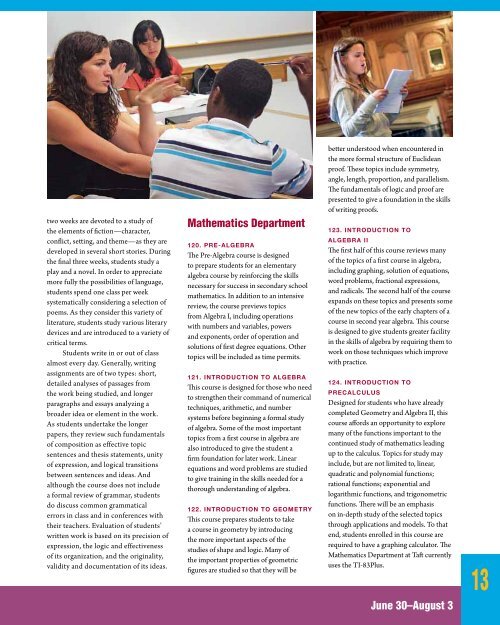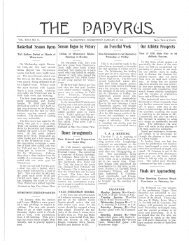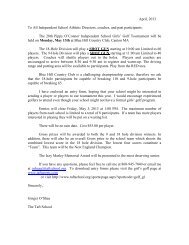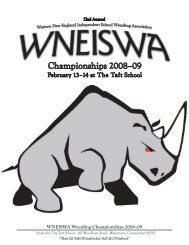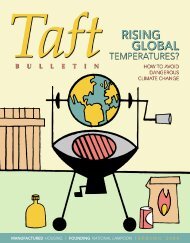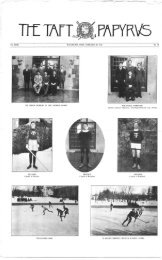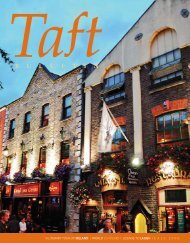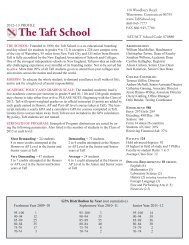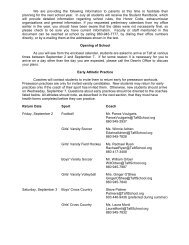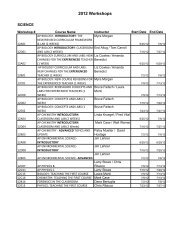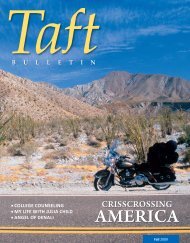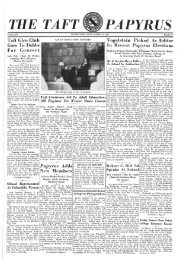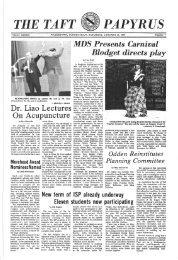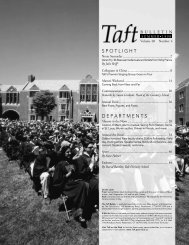100-Level coursesL112English DepartmentWhile several courses of varying levels of complexity are offered, the primary goals ofthe summer school English program are to teach students to write and speak clearlyand to help them to analyze and understand what they read. Small classes allowteachers to evaluate student writing regularly and thus enable each individual todevelop the ability to communicate ideas more effectively. <strong>The</strong> content of the readingsis of secondary importance as the aim of our program is the development of techniquesthat will enable students to better deal with the tasks of writing and analysis in futurecourses in their schools.* International Students: Placement in the appropriate English program is determined bythe scores on a placement test and through a writing sample provided by each student on the firstday of classes.110. Literature andComposition IIntended for students entering theseventh and eighth grade, this coursefocuses on building fundamental readingand writing skills. Most classes combinea consideration of the principles of clearwritten expression with the close, criticalreading of narrative and dramatic fiction.A review of grammatical principles laysthe foundation for studying expressionat the level of the sentence, andparticular attention is paid to effectiveuse of coordination and subordinationand to correcting common sentencefaults. Concurrently, students learn towrite focused, purposefully developedexpository paragraphs, and during thelast week, they compose a completeessay. Significant time is spentapproaching systematically the varioussteps of the writing process, includingbrainstorming to generate ideas,selecting appropriate organizationalstrategies, outlining, and revising andediting a rough draft in order to producea polished expression.Students read a selection of shortstories and either a short novel or a play.Seminar-style class discussions stress thecritical approach to literature; in thesediscussions students learn about theelements of fiction as they learn to readclosely and carefully. To complement thisendeavor, students regularly write shortparagraphs in which they closely analyzepassages from the reading. Those who takethis course can expect to enter the seventhor eighth grade having become moredisciplined and more confident readersand writers.111. Literature andComposition IIDesigned for students entering the ninthand tenth grades this course strives tomake students more disciplined, effectivewriters and more careful, thoughtfulreaders. Students devote half of theirtime in and out of class to masteringthe skills necessary to write clearly andpurposefully; they spend the remainderof their time learning to read and analyzechallenging literature.<strong>The</strong> writing instruction is designedto enhance students’ command of writtenexpression. <strong>The</strong>y learn to composegrammatically sound, controlledsentences by reviewing the principlesof grammar, paying particular attentionto common sentence faults and toeffective coordination and subordination.Concurrently, students are instructedin the fundamentals of paragraphconstruction: they learn to composeeffective topic sentences and to employa variety of strategies to develop thosetopic sentences in a unified and coherentfashion. Finally, as they write papers onspecific topics, students are systematicallyexposed to the various stages of thewriting process. <strong>The</strong> course reviews the“My daughter truly loved<strong>Taft</strong> this summer. <strong>Taft</strong>sparked an intellectualcuriosity in her,impressing both myhusband and I.”techniques of brainstorming, organization(outlining and “mapping”), and editing,and it stresses the importance of detail toclear expression. Throughout the session,students prepare a number of papers—paragraphs at the outset and completeessays in the last two weeks—on topicsranging from personal narratives toliterary analysis.Students become more skilledreaders by considering a selection of shortstories and a novel. Class discussions,focused on the close reading of specificpassages, teach the students to readcarefully and critically. <strong>The</strong>ir analyticalskills become more finely tuned as theylearn about the elements of fiction andabout specific literary devices. This criticalapproach is complemented by regularshort written exercises in which studentslearn to express clearly their reactions towhat they read.112. Literature andComposition IIIThis course, designed for studentsentering the eleventh and twelfth grades,resembles Literature and CompositionII in that it also stresses the developmentof students’ abilities to write clearly andto read critically. However, it is muchmore ambitious and sophisticated in itsapproach to both goals.<strong>The</strong> course resembles a collegeseminar in that its focal point is readingand writing about literature. <strong>The</strong> first<strong>Taft</strong> Summer <strong>School</strong>
two weeks are devoted to a study ofthe elements of fiction—character,conflict, setting, and theme—as they aredeveloped in several short stories. Duringthe final three weeks, students study aplay and a novel. In order to appreciatemore fully the possibilities of language,students spend one class per weeksystematically considering a selection ofpoems. As they consider this variety ofliterature, students study various literarydevices and are introduced to a variety ofcritical terms.Students write in or out of classalmost every day. Generally, writingassignments are of two types: short,detailed analyses of passages fromthe work being studied, and longerparagraphs and essays analyzing abroader idea or element in the work.As students undertake the longerpapers, they review such fundamentalsof composition as effective topicsentences and thesis statements, unityof expression, and logical transitionsbetween sentences and ideas. Andalthough the course does not includea formal review of grammar, studentsdo discuss common grammaticalerrors in class and in conferences withtheir teachers. Evaluation of students’written work is based on its precision ofexpression, the logic and effectivenessof its organization, and the originality,validity and documentation of its ideas.Mathematics Department120. Pre-Algebra<strong>The</strong> Pre-Algebra course is designedto prepare students for an elementaryalgebra course by reinforcing the skillsnecessary for success in secondary schoolmathematics. In addition to an intensivereview, the course previews topicsfrom Algebra I, including operationswith numbers and variables, powersand exponents, order of operation andsolutions of first degree equations. Othertopics will be included as time permits.121. Introduction to AlgebraThis course is designed for those who needto strengthen their command of numericaltechniques, arithmetic, and numbersystems before beginning a formal studyof algebra. Some of the most importanttopics from a first course in algebra arealso introduced to give the student afirm foundation for later work. Linearequations and word problems are studiedto give training in the skills needed for athorough understanding of algebra.122. Introduction to GeometryThis course prepares students to takea course in geometry by introducingthe more important aspects of thestudies of shape and logic. Many ofthe important properties of geometricfigures are studied so that they will bebetter understood when encountered inthe more formal structure of Euclideanproof. <strong>The</strong>se topics include symmetry,angle, length, proportion, and parallelism.<strong>The</strong> fundamentals of logic and proof arepresented to give a foundation in the skillsof writing proofs.123. Introduction toAlgebra II<strong>The</strong> first half of this course reviews manyof the topics of a first course in algebra,including graphing, solution of equations,word problems, fractional expressions,and radicals. <strong>The</strong> second half of the courseexpands on these topics and presents someof the new topics of the early chapters of acourse in second year algebra. This courseis designed to give students greater facilityin the skills of algebra by requiring them towork on those techniques which improvewith practice.124. Introduction toPrecalculusDesigned for students who have alreadycompleted Geometry and Algebra II, thiscourse affords an opportunity to exploremany of the functions important to thecontinued study of mathematics leadingup to the calculus. Topics for study mayinclude, but are not limited to, linear,quadratic and polynomial functions;rational functions; exponential andlogarithmic functions, and trigonometricfunctions. <strong>The</strong>re will be an emphasison in-depth study of the selected topicsthrough applications and models. To thatend, students enrolled in this course arerequired to have a graphing calculator. <strong>The</strong>Mathematics Department at <strong>Taft</strong> currentlyuses the TI-83Plus.13June 30–August 3


